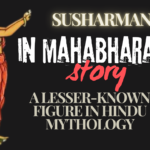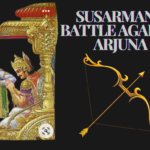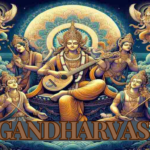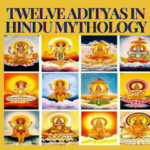Hastinapura, the ancient capital of the Kuru kingdom, is renowned for its rich history and tales of valor. Among these stories, the marriage of King Shantanu and the Goddess Ganga stands out as a captivating blend of romance, divine mystery, and the fulfillment of celestial purposes.
Shantanu: The Beloved King of Hastinapura.
Shantanu, a ruler famed for his valor and wisdom, was deeply loved by his subjects. His reign was marked by justice, charity, and a commitment to Dharma. The people of Hastinapura were inspired by his virtuous leadership and lived in harmony, following the path of righteousness he so steadfastly upheld.
The Fateful Meeting by the Ganga.
One day, while hunting in the forests, Shantanu found himself walking along the banks of the sacred river Ganga. It was here that he encountered a damsel of extraordinary beauty and divine aura. This ethereal maiden was none other than the Goddess Ganga herself. Enchanted by her presence, Shantanu had never seen such beauty before and was instantly captivated.
The Divine Proposal.
Ganga, aware of Shantanu’s admiration, approached him and said, “O King, I shall be your wife and obey your commands, but on one condition. You must not question me about myself and shall not interfere with whatever I do, be it agreeable or disagreeable. Nor shall you ever address me unkindly. As long as you abide by my conditions, I promise that I shall live with you. But I shall certainly leave you the moment you interfere with me or speak to me an unkind word.”
Despite the unusual nature of her request, Shantanu, driven by love and reverence for Ganga, agreed to her terms. Thus began their life together, marked by both joy and an underlying mystery.
Life Together and the Birth of Divine Children.
Years passed, and Shantanu and Ganga lived happily. Their union resulted in the birth of seven children, each possessing god-like beauty. However, with each birth, Ganga performed a shocking act: she threw each newborn into the Ganges, declaring, “This is for your good.”
Though horrified, Shantanu kept his silence, honoring his promise to Ganga. He watched in silent agony as his children were sacrificed, unable to intervene or question his wife’s actions.
The Breaking Point.
The birth of the eighth child was a turning point. As Ganga prepared to throw the infant into the river, Shantanu, unable to bear the sorrow any longer, protested. With a sorrowful countenance, he implored, “Please spare me at least this child. Why do you kill your own children? And for what purpose are you indulging in this cruel deed? Who are you in fact?”
Ganga Reveals Her True Identity.
In response to Shantanu’s heartfelt plea, Ganga revealed her true identity and the purpose behind her actions. She said, “O King, in complying with your wish I shall spare this child of yours. Since you have broken your promise now, I shall take leave of you. I am Ganga, the daughter of Jahnu, ever worshipped by sages. I have lived with you so long for accomplishing the purpose of the celestials. These eight sons are the eight Vasus who had to be born on earth because of a curse. No one but I could have been their mother. Also, none else but you deserved the honor of being their father. Having become their father, you have acquired manifold merits.”
The Curse of the Vasus.
The eight children were indeed the eight Vasus, celestial beings who had been cursed to be born on earth. Their crime was stealing the divine cow Nandini, which belonged to the sage Vasishta. The curse decreed that they would be born as humans, but Ganga, taking pity on them, agreed to liberate them from their mortal lives immediately after birth, except for the youngest Vasu, who was to suffer a longer life due to his greater involvement in the theft. This youngest Vasu would grow to be the illustrious Bhishma, a central figure in the epic Mahabharata.
The Aftermath and Shantanu’s Sorrow.
With Ganga’s departure, Shantanu was left heartbroken. He had lost not only his beloved wife but also witnessed the tragic fate of his children. The spared child, Bhishma, was raised with great care and eventually became one of the most revered and respected warriors and statesmen of his time. Shantanu’s legacy, intertwined with divine destiny and celestial purposes, continued through Bhishma, whose life was a testament to duty, honor, and sacrifice.
So Folks this is the story of King Shantanu marrying Ganga.
The tale of Shantanu and Ganga is a profound narrative of love, sacrifice, and divine intervention. It highlights the complexities of adhering to vows, the pain of unfulfilled promises, and the mysterious ways in which destiny unfolds. Shantanu’s story serves as a reminder of the intricate balance between human desires and divine will, a theme that resonates deeply within the rich tapestry of Indian mythology.




